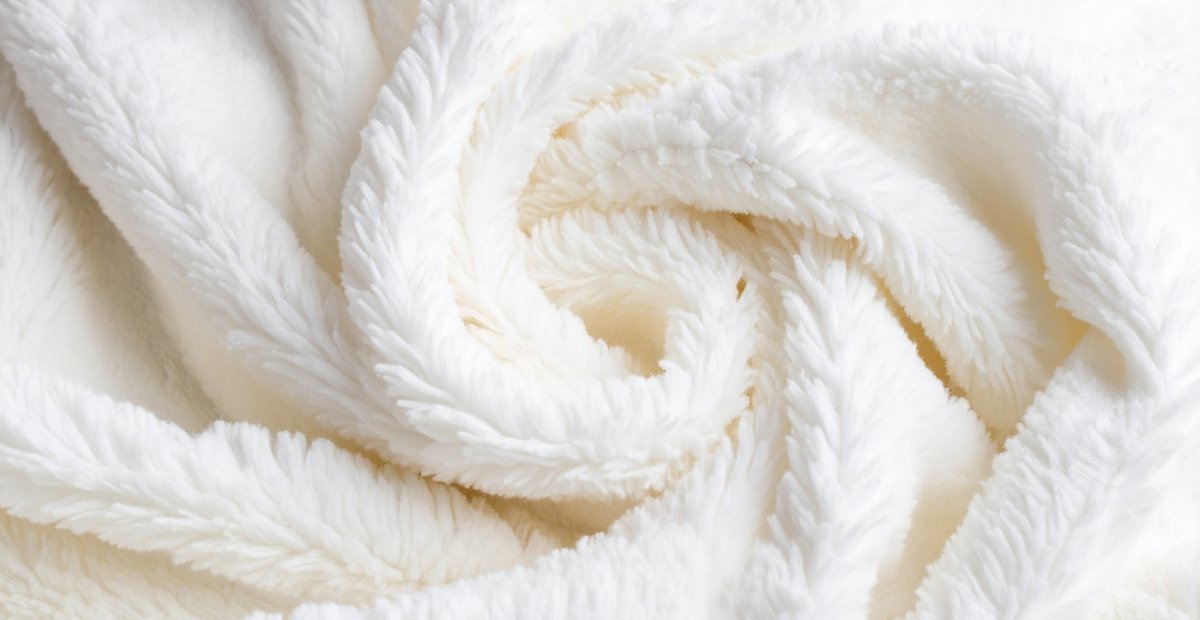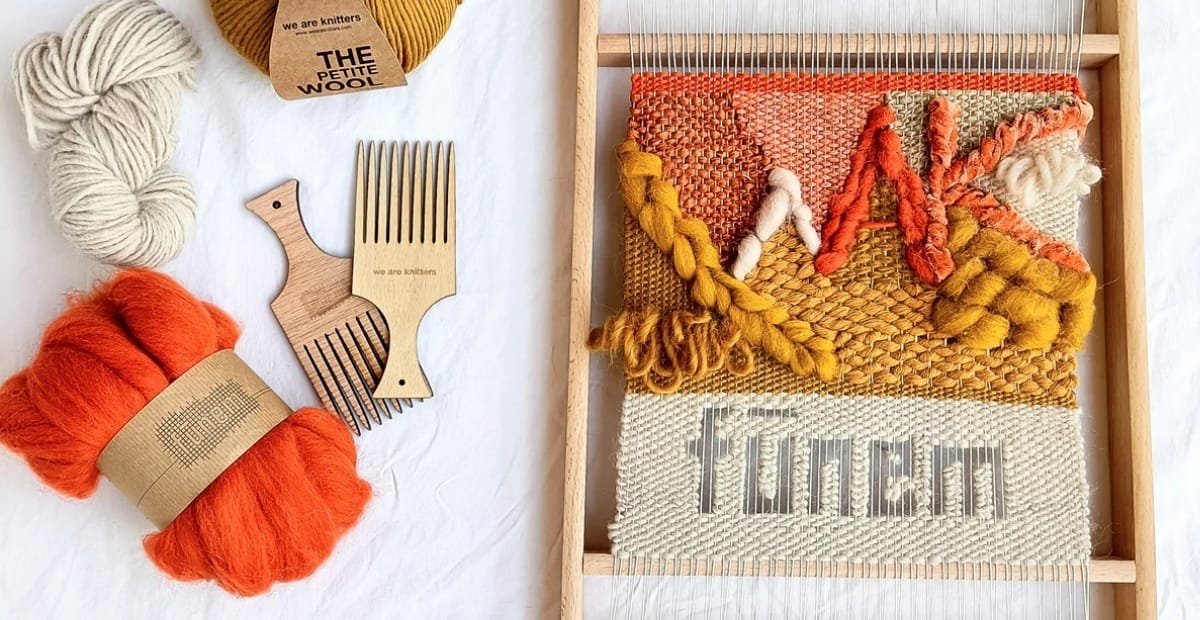When the temperature falls and you want something to feel snug and warm, Sherpa cotton fabric is the go to fabric. Sherpa cotton is almost the warmest and coziest fabric there is, while also being breathable. Sherpa cotton can be used to make jackets and blankets and even home decor.
Sherpa cotton fabric is a favorite because of its unique qualities. In this guide you will understand everything there is to know about Sherpa cotton fabric; its origin, texture, uses, benefits, instructions on how to take care of it, and styling suggestions.
What is Sherpa cotton fabric?
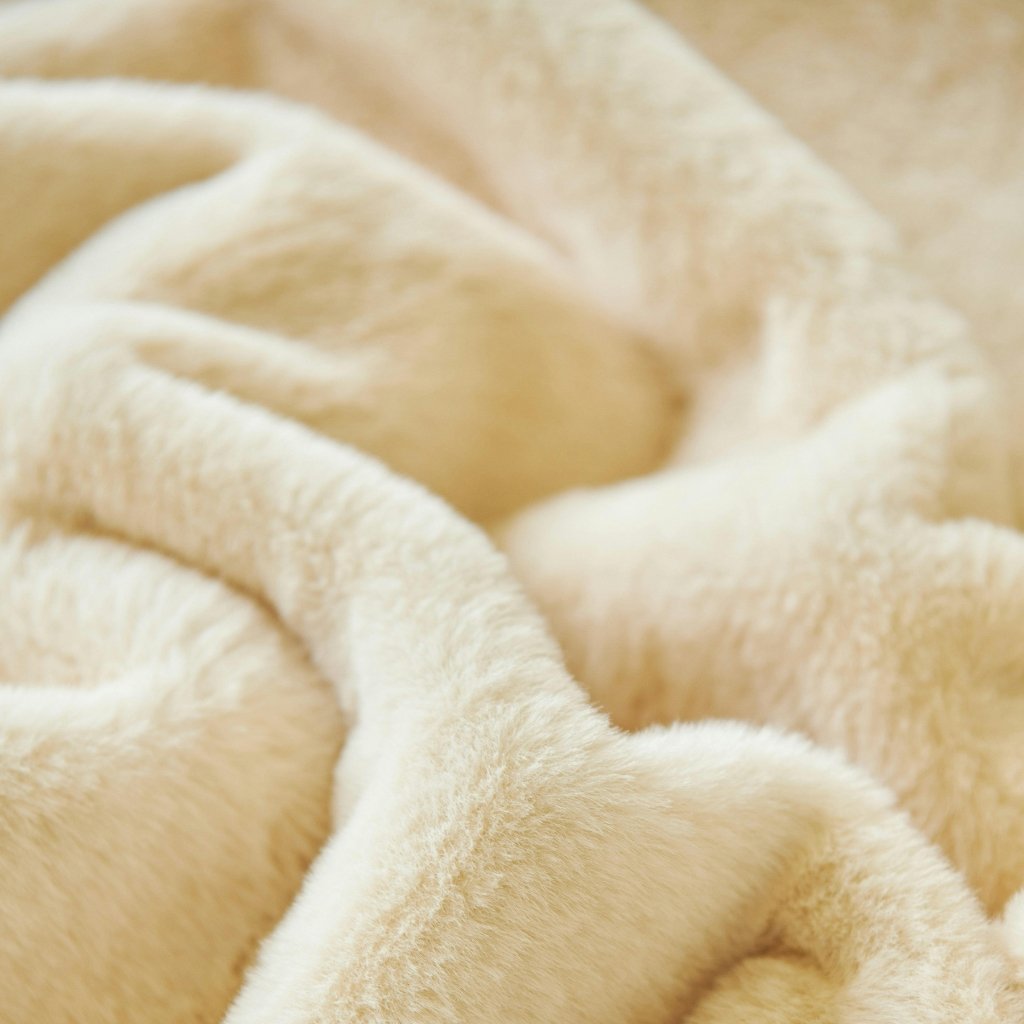
Sherpa cotton fabric is a type of fabric that is made from cotton, or a combination of cotton and polyester. It is designed to feel and look like sheep wool. Sherpa cotton is lightweight in comparison to sheep wool, and it is also easier to look after. One side of the fabric is smooth while the other side is fluffy like the fleece of a lamb.
Sherpa cotton is soft, insulating, and allows air flow. It is also gentle on the skin, making it ideal for clothing, blankets, and accessories.
The Origin and History of Sherpa Fabric
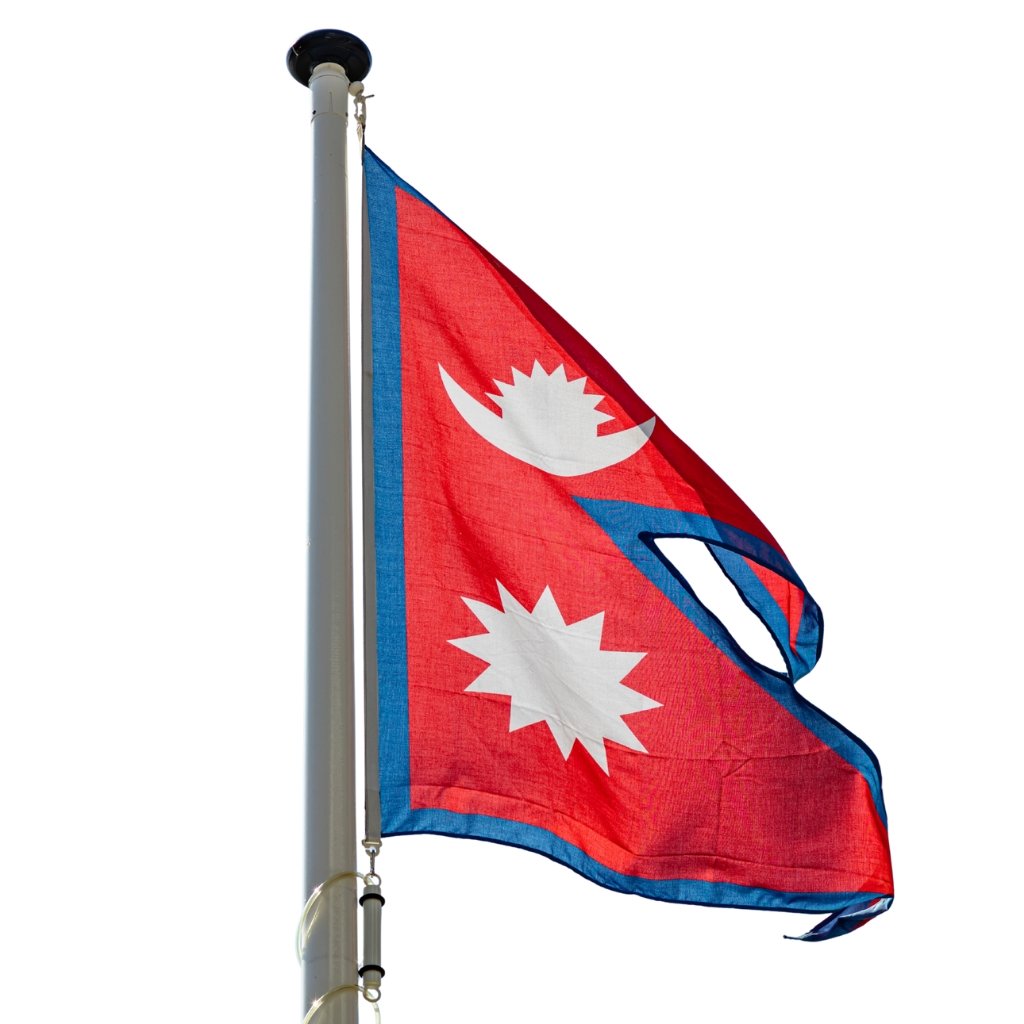
The word Sherpa comes from the Sherpa people of Nepal. The Sherpa people live in the cold Himalayas. Wool-lined clothing made by the Sherpa inspired fabric manufacturers. People wanted to replicate the warmth of wool, but take the heaviness of real wool out of the equation.
As time progressed, people started to prefer cotton for Sherpa fabric. Cotton is renewable, hypoallergenic, and easy to care for. Sherpa cotton is also used in apparel brands that focus on comfort, in home decor, and in sustainable, environmentally-friendly clothing of the modern eco apparel brands.
How Sherpa Cotton Fabric Is Made Beginning with the fluffiness Like Wool
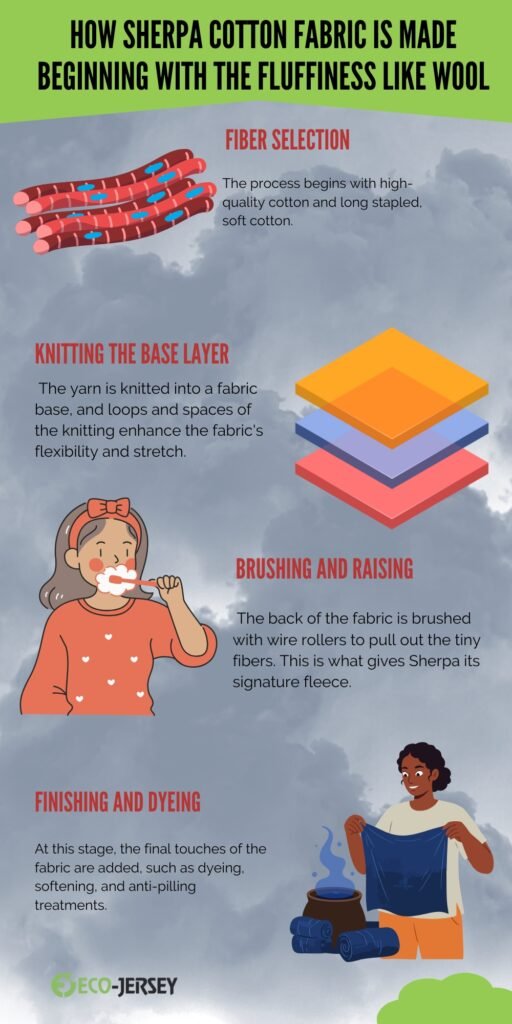
Fiber Selection – The process begins with high-quality cotton and long stapled, soft cotton. Sometimes, a small percentage of polyester is added to improve resilience and reduce shrinkage, but it is usually.
Knitting the Base Layer – The yarn is knitted into a fabric base, and loops and spaces of the knitting enhance the fabric’s flexibility and stretch.
Brushing and Raising – The back of the fabric is brushed with wire rollers to pull out the tiny fibers. This is what gives Sherpa its signature fleece.
Finishing and Dyeing – At this stage, the final touches of the fabric are added, such as dyeing, softening, and anti-pilling treatments. After this, the fabric feels lightweight yet warm, soft yet durable.
The result is a luxuriously plush textile that combines the coziness of wool with the breathability of cotton.
Advantages of Sherpa Cotton Fabric
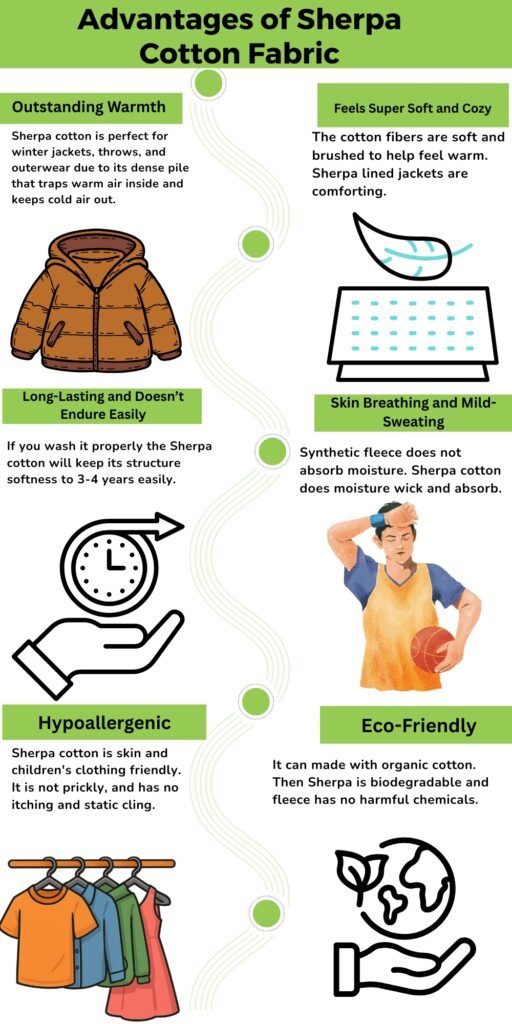
- Outstanding Warmth
Sherpa cotton is perfect for winter jackets, throws, and outerwear due to its dense pile that traps warm air inside and keeps cold air out. It even looks heavy, yet surprisingly light effortless.See more….Corduroy Cotton Fabric
- Feels Super Soft and Cozy
The cotton fibers are soft and brushed to help feel warm. Sherpa lined jackets are comforting. You can wrap Sherpa lined jackets and blankets as well. You will not feel any irritation.
- Skin Breathing and Mild-Sweating
Synthetic fleece does not absorb moisture. Sherpa cotton does moisture wick and absorb. Plus it allows skin to breathe. Fore-Active movement like walking a lot it helps with sweating and shy discomfort.
- Long-Lasting and Doesn’t Endure Easily
If you wash it properly the Sherpa cotton will keep its structure softness to 3-4 years easily. And with no pilling-tearing- flattening you can safely say it is worth the investment. Read more…..Canvas Cotton Fabric
- Hypoallergenic
Sherpa cotton is skin and children’s clothing friendly. It is not prickly, and has no itching and static cling.
- Eco-Friendly
It can made with organic cotton. Then Sherpa is biodegradable and fleece has no harmful chemicals.
Common Uses of Sherpa Cotton Fabric
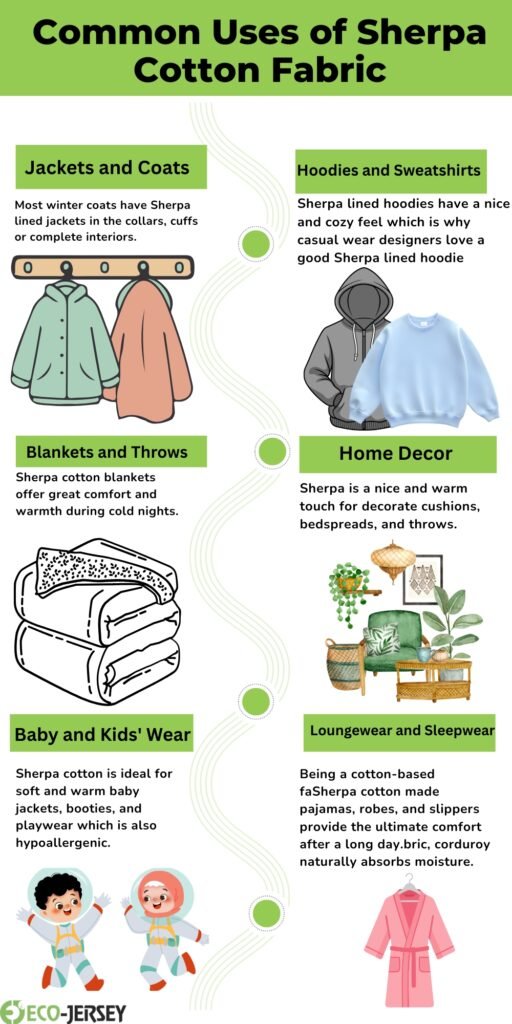
Sherpa cotton is very versatile.
- Jackets and Coats
Most winter coats have Sherpa lined jackets in the collars, cuffs or complete interiors. It adds warmth in the winter without the added weight of the coat.
- Hoodies and Sweatshirts
Sherpa lined hoodies have a nice and cozy feel which is why casual wear designers love a good Sherpa lined hoodie. They’re comfortable and are great for lounging, walking outside, or going on a trip.
- Blankets and Throws
Sherpa cotton blankets offer great comfort and warmth during cold nights. Their soft, fluffy surface works like a feel and breathable cooling cotton.Read more….French Terry Fabric
- Home Decor
Sherpa is a nice and warm touch for decorate cushions, bedspreads, and throws. It gives a lovely rustic look to the home during winter which adds warmth and is great for winter season.
- Baby and Kids’ Wear
Sherpa cotton is ideal for soft and warm baby jackets, booties, and playwear which is also hypoallergenic. It will warm and comfort kids while keeping irritation away.
- Loungewear and Sleepwear
Sherpa cotton made pajamas, robes, and slippers provide the ultimate comfort after a long day.
“`html| Feature | Sherpa Cotton Fabric | Fleece Fabric |
|---|---|---|
| Material | Natural cotton or cotton blend | Usually synthetic polyester |
| Texture | Soft, wool-like, fluffy | Smooth, brushed both sides |
| Warmth | Excellent insulation | High warmth but less breathable |
| Breathability | High | Moderate |
| Eco-Friendliness | Biodegradable, sustainable | Non-biodegradable |
| Maintenance | Easy with proper care | Easier and dries faster |
While fleece might be easier to dry, Sherpa cotton wins in breathability, comfort, and eco-friendliness.
How to Care for Sherpa Cotton Fabric
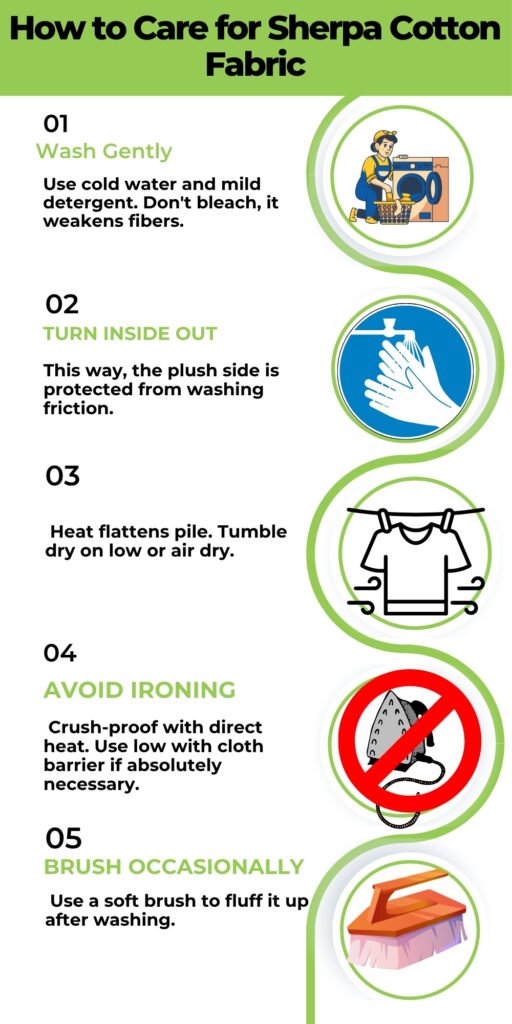
To keep your Sherpa cotton items fluffy and fresh, here is how to care for them.
Wash Gently: Use cold water and mild detergent. Don’t bleach, it weakens fibers.
Turn Inside Out: This way, the plush side is protected from washing friction.
Air Dry: Heat flattens pile. Tumble dry on low or air dry.
Avoid Ironing: Crush-proof with direct heat. Use low with cloth barrier if absolutely necessary.
Brush Occasionally: Use a soft brush to fluff it up after washing.
These steps will help your Sherpa cotton fabric to maintain its soft, luxurious texture for a long time.
Environmental Benefits of Sherpa Cotton
The Sherpa that’s made from cotton is eco-friendly and much better than synthetic fleece! It is compostable, renewable, and biodegradable. Also, if it is made from organic cotton, it will be even better, as it will lower the use of chemicals and water waste.
Using Sherpa cotton contributes to sustainable fashion, and it is a positive step towards reducing microplastic pollution and unethical textile production. Read more…..Poplin Cotton Fabric
Disadvantages of Sherpa Cotton Fabric
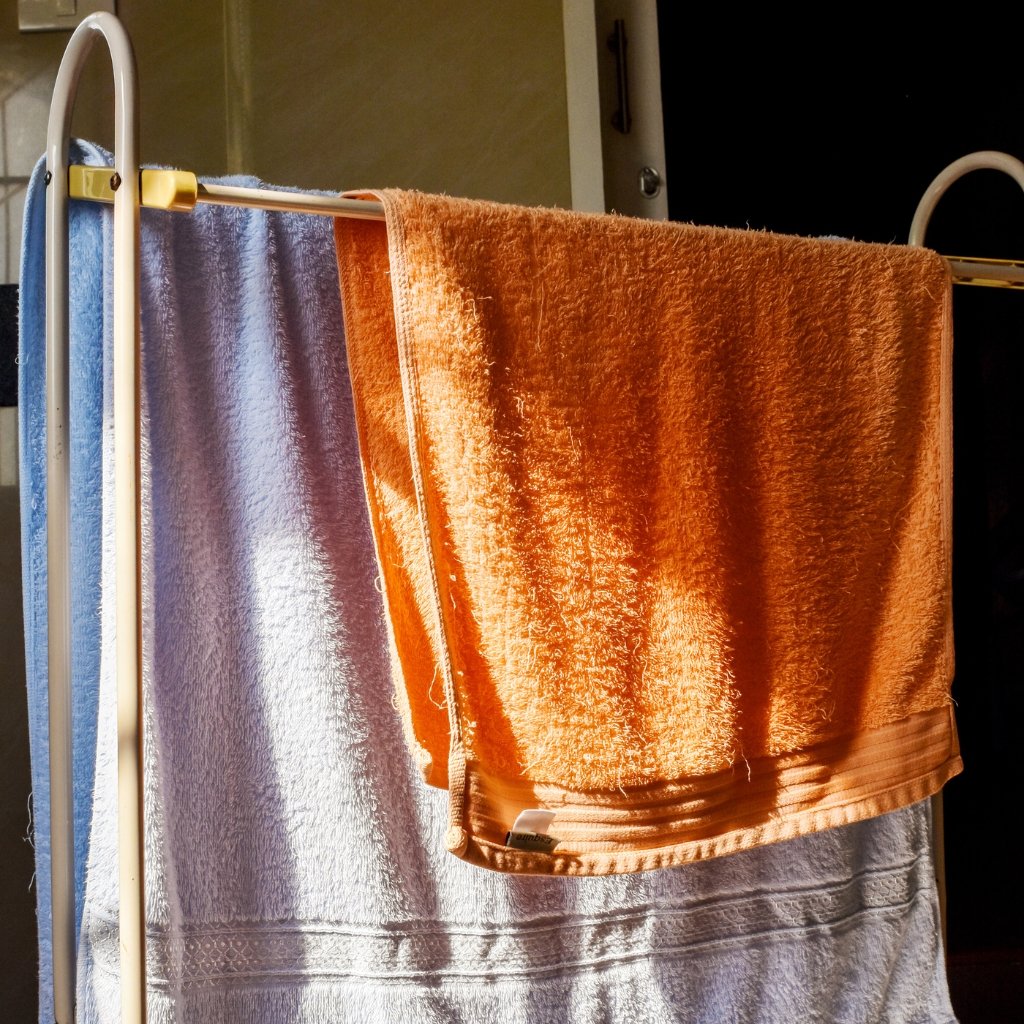
Sherpa cotton has a few downsides despite all the advantages that it has.
- Hot water shrinkage.
- Long drying time due to the thick pile.
- Without care, drying, and use, the matting and flattening of the surface will occur.
- In certain activewear, its weight will bear an impact as it is heavier than polyester fleece.
The remaining downsides, which include the natural source, warmth, and comfort of the fabric, will be overshadowed.
Styling Ideas with Sherpa Cotton

Sherpa cotton is versatile, and it can improve the style of your wardrobe and the décor of your house.
Fashion Tip: For a cozy winter look, wear a Sherpa-lined denim jacket with some boots.
Casual Wear: For an easy and stylish outfit, wear joggers with a Sherpa-hoodie.
Home Touch: Add some Sherpa blankets or cushion covers to your living room for added warmth and texture.
Outdoor Use: For road trips and cool evenings, keep a Sherpa throw in your car.
With its neutral shades of cream, beige, gray, and brown, it goes great with pretty much every color scheme out there.
More Modern Brands with Sherpa Cotton
Since Sherpa cotton is renewable and biodegradable, modern brands are switching to it for their eco friendly collections. Sherpa cotton also looks versatile and has a luxurious feel, so it’s great for designers to work with.
With Sherpa cotton, consumers enjoy greater comfort and lower their carbon footprint, so it’s a win for both the environment and the customers
“`html| Aspect | Summary |
|---|---|
| Material | Sherpa cotton is made from natural cotton or cotton blends, while fleece is typically synthetic polyester. |
| Texture | Sherpa cotton has a soft, wool-like, and fluffy feel, whereas fleece is smooth and brushed on both sides. |
| Warmth | Both fabrics offer warmth, but Sherpa cotton provides excellent insulation with better breathability. |
| Breathability | Sherpa cotton is highly breathable, while fleece has moderate airflow and can feel less airy. |
| Eco-Friendliness | Sherpa cotton is biodegradable and sustainable, making it an eco-friendly choice compared to non-biodegradable fleece. |
| Maintenance | Sherpa cotton requires gentle care but remains durable; fleece dries faster and is easier to maintain. |
| Overall Comparison | While fleece is easier to dry, Sherpa cotton excels in comfort, breathability, and environmental sustainability. |
Conclusion
In a world of increased focus on comfort and sustainability, the blend of luxury and practicality has made Sherpa cotton fabric so popular. It is warm enough to keep you cozy during winter, soft enough for everyday wear, and natural enough for eco friendly living.
No matter if you put it on, in your home, or with your accessories, Sherpa cotton will always give you cozy warmth and a classic look. After feeling the softness, it is easy to see why this fabric has become so popular in every modern home.
FAQs
What is Sherpa cotton fabric made of?
Sherpa cotton fabric is made from 100% natural cotton or a cotton-polyester blend. Its wool-like texture provides warmth and softness without irritation.
Is Sherpa cotton fabric eco-friendly?
Yes, when made from 100% cotton, it is biodegradable and sustainable, making it an eco-friendly alternative to synthetic fleece.
What are the common uses of Sherpa cotton fabric?
Sherpa cotton is used in jackets, hoodies, blankets, home décor items, and loungewear because of its plush texture and excellent insulation.

